| |
11월 5일부터 28일까지 아트포럼뉴게이트에서 김춘수의 개인전이 열린다.
시간의 힘을 보여줘!
김정락 | 미술사학, 김종영미술관 학예실장
캔버스 화면은 대개 청과 백의 두 가지 색을 손으로 직접 칠한 흔적으로 채워진다. 이 단순한 손의 흔적이 화면을 요동치게 만들어 놓는다. 물감에 가해진 힘과 방향 그리고 반복되는 흐름과 율동이 한 캔버스를 작품으로 승화시킨다. 이렇게 김춘수의 작품은 가장 단순한 회화원리에 대한 무궁한 사유의 결과로서 출현한다. 회화의 표면은 그래서 기본적인 요소들이 어떻게 결합하는가에 대한 문제의 답변이 된다. 회화에 사용된 원리들은 김춘수의 지극히 격렬한 사유의 과정을 거치면서 물질을 활성화하는 도구로서 그 의미를 획득하게 된다. 회화는 바로 이러한 과정에서 주술적인 행위가 될 수 있다. 만약 그렇다면, 작가는 빈 캔버스 위에서 힘 혹은 운동으로 형성된 시간과 회화의 표면이라는 정지 상태를 결합시키는 사유의 연금술사라고 정의할 수 있겠다.
김춘수의 울트라마린 청색은 우선 의미론적 정체성을 구축한 후에 회화의 표현형식으로 이전된다. 그러니까 울트라마린은 Ultra와 Marine이란 두 단어가 결합된 단어이고, 이것의 의미를 해석의 차원으로 올려놓으면, 바다를 초월하는 혹은 바다의 색인 마린을 초극하는 어떤 높은 차원을 의미한다고 해석되는 것이다. 실제로 그의 그림들은 바다와 닮았거나 그것을 연상시키기에 충분하다. 요동치는 물감의 흔적들은 바람에 이는 물결이나 광폭한 파도가 된다. 캔버스의 고요했던 죽음의 표면은 그의 행위로 인하여 심하게 요철하고 끊임없이 출렁이는 자연의 유기체적인 생명이 된다. 푸른색 손질로 화면을 가득채운 김춘수의 회화는 이전 유사한 색을 자신의 트레이드마크처럼 사용했던 이브 클라인을 연상하게 만든다. 클라인의 청색은 단지 덮어 씌워진 표면이 되거나 표면을 지향하는 물체의 속성을 중립적으로 윤색하는 역할을 수행한다. 이에 반하여 김춘수의 것은 표면의 장력으로부터 확장되어 나온 일종의 힘으로서 나타난다. 물론 이 힘은 백색과의 역학적인 대립 속에서 형성된 것이다. 그리고 이 대립 항이 물질의 부피나 무게가 아니라 순수한 운동이라는 인상을 주면서 회화의 표면을 중심에 두고 분할되는 내, 외부는 공간으로 자리를 잡는다.
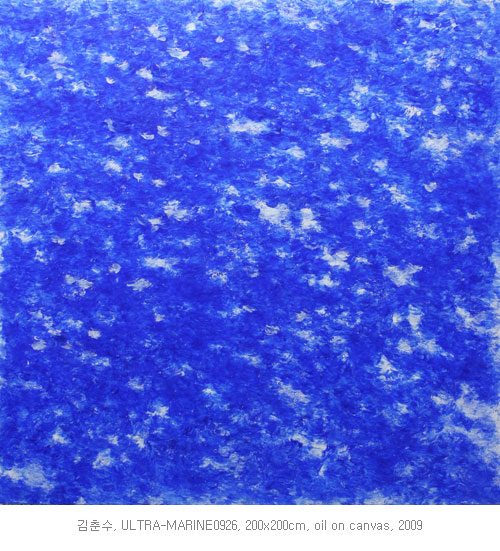
최근의 작품은 이러한 유사성이 변주될 지평을 넓혀놓은 느낌을 준다. 백색이 더 많이 가미되어졌고, 이와 더불어 이전의 격렬한 운동도 안정적으로 변해간 것을 확인할 수 있다. 또한 캔버스의 크기도 이전과 비교할 때 진정된 크기로 소급되어 있는 것 같다. 과거 작가는 큰 화면에 격렬한 운동성으로 감각의 수용한계를 넘어서며, 일종의 숭고미와 유사한 감정들에 주력하였다. 그러나 이제 그는 보다 내밀한 운동성에 접근한 것 같고, 또한 그 내밀성을 위하여 크기가 가진 위협적인 인상을 누그러뜨렸다. 하지만 숭고미는, 시각적인 차원에서, 안전을 위한 거리를 확보한 후에 전달되는 미 감정이었지만, 최근의 작품들은 관객을 물리적으로 보다 가깝게 불러들이면서, 다른 감상의 성격을 부여하고 있는 셈이 되었다.
이 신작들은 바다를 연상시키는 이전의 형상유사성(analogy)에서 더 나아갔다. 로잘린드 크라우스(Rosalind Kraus)식으로 말하자면, 이제 김춘수의 회화는 더욱 자기지시적인 성격을 보여준다고 하겠다. 이와 더불어 리터러시는 상대적으로 감소되었다. 약간 쉽게 풀이하면 김춘수의 회화는 연상의 고리를 끊고, 그 자체인 회화표면으로 환원한 것이다. 그러니까 모더니즘 회화론이 주장하는 그 원리적인 궁극점에 도달한 셈이다. 이런 도식으로 본다면 별 재미가 없다. 이 도식을 깰 근거는 바로 그 작품이 제공한다. 김춘수의 회화는 캔버스를 대면하여 작가가 수행했던 작업의 과정과 그 시간을 재현한 것으로 정의하면 보다 풍부한 의미를 얻을 수 있다. 결과를 먼저 정리해 보면, 캔버스 표면의 질감은 더욱 잘 인지되고, 손질의 흔적은 그 자체로서 존재감을 얻었고, 흘러내린 물감의 흔적에서 중력과 물질 사이에 대응을 읽어낼 수 있다. 전체적인 화면을 본다면, 더욱 간략해진 느낌을 받는다. 이것은 화가가 이전과는 달리 단호한 의지로서 손질(=회화행위)을 감행하고 있다는 것을 반증한다. 또한 행위의 궤적도 명료해졌다. 손질은 이제 행위의 역동성뿐만 아니라 색을 이루는 원료의 성질까지 잘 드러내준다. 여러 부분에서 찾을 수 있는 얼룩이나 의도적인 제어에서 벗어난 듯한 자국들은 행위의 시간이 구성한 결과들이라고 할 수 있다.
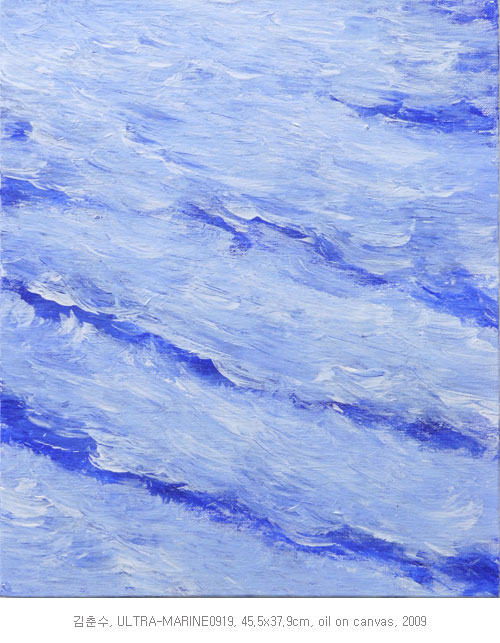
하지만 이전의 회화가 지닌 형질 또한 유지되고 있다. 화면을 사선으로 가로지르는 방향성은 이전의 가파른 경향을 완화했지만 여전히 인식되는 부분이다. 손질의 강도도 공격적인 성향에서 진정된 추세로 나가지만, 언급하였듯이 더욱 더 단호해졌다. 이로서 작가는 자신의 작품이 나아가는 경로와 과정을 선명하게 표시하고 있다. 필자와 같은 미술사가들에게 이러한 분명한 발전상은 반갑고 또한 고맙다. 이것은 또한 작가의 사고와 실천이 논리적인 발전을 하고 있다는 것을 의미하며, 또한 지속적이고 발전적이라고 말할 수 있는 근거가 된다. 이번 전시를 통해 본 김춘수의 회화는 회화성의 근원에 다가가서 결국의 시간의 힘을 남기고, 그 관념의 바다로부터 탈출해 나 온 여정을 보여주는 기록과 같다.
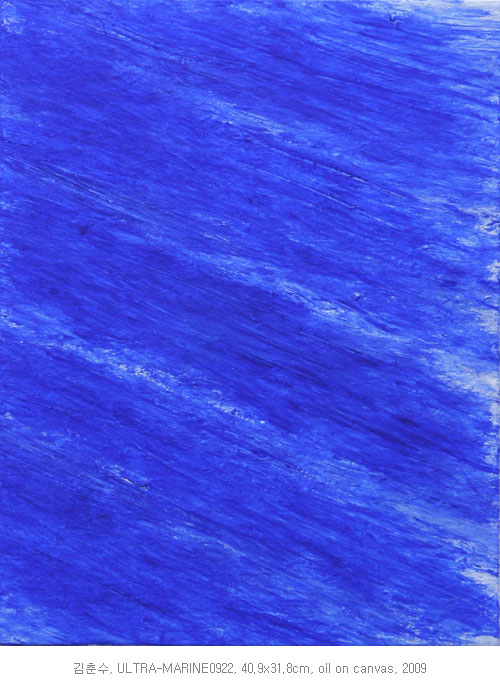
Show us the power of time!
Kim, Jung-Rak | Art Historian, Head Curator of the Kim Chong Yung Sculpture Museum
The canvas is generally filled with traces directly applied by the artist's hands using the two colors of blue and white. These simple traces of the hands turn the picture-plane into a field of turbulence. The force and direction added to the paint, and the repeated flow and rhythm sublimate the canvas into a work of art. Thus the works of Kim Tschoon-Su emerge as a result of endless contemplation about the simplest principles of painting. So the surface of the painting becomes the answer to the question of how the basic elements merge with one another. The principles used in the paintings gain their significance as tools to activate matter, as they go through the extremely intense thought process of the artist. It is in such a process that painting can become an act of incantation. If this is so, we can define the artist as an alchemist of thought, who combines time—formed by force or movement on the empty canvas—and the stationary state known as the painting surface.
Kim Tschoon-Su's ultramarine blue is transferred to a form of expression in the painting only after constructing its semantic identity. That is to say, as the word ultramarine is a combination of 'ultra' and 'marine,' if we bring the significance of this up to a dimension of interpretation, it means a certain higher dimension that transcends the ocean or the color of the ocean. In fact, Kim's paintings sufficiently resemble or remind viewers of the sea. The pitching and rolling traces of paint become waves rising in the wind or wild billows. The canvas's tranquil surface of death, thanks to his actions, become organic life forms of nature, endlessly jolting and surging. Filled with bluish touches, the artist's paintings may be associated with Yves Klein, who previously used a similar color as if it were his trademark. Klein's blue merely became covered-over surfaces, or played the role of embellishing characteristics of objects, inclining to be a surface, in a neutral manner. On the other hand, Kim Tschoon-Su's blue emerges as a certain power that has extended out from the tension of the surface. Of course this force is formed in the dynamic confrontation with the white. And as these opposing items give the impression of pure movement, rather than volume or weight of matter, the interior and exterior, which divide surrounding the surface of the painting, establish themselves as space.
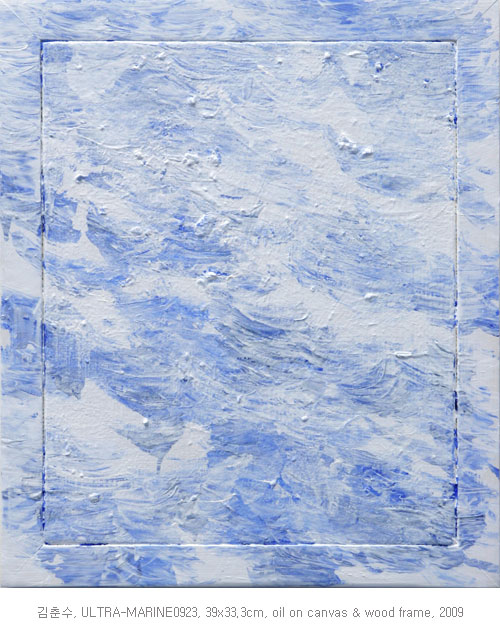
Kim's recent works give the impression that they widened the horizon for such variations of similarity. More white has been added, and the previously violent movement has clearly changed towards stability. Furthermore, when we compare the sizes of the canvases to former works, they seem to taking calmed-down size. In the past, the artist had focused on a certain sublime beauty and similar emotions, as he overcame the limit of senses through violent movement on large-scale picture-planes. But now he seems to be approaching more intimate mobility, and softening the intimidating impression of size for the sake of that intimacy. However, while the sublime beauty was an aesthetic emotion that was communicated after establishing a 'safe distance' in terms of visual dimension, the recent works called in the spectators physically closer to provide a different type of appreciation.
The latest works advanced further from the previous analogy that resembled the sea. To put it in a Rosalind Kraus way of speech, now Kim's paintings show a more self-indicative characteristic. Furthermore, the literacy relatively decreased. An easier explanation is that Kim Tschoon-Su's paintings severed their links to association, and were restored to their own painting surfaces. That is to say they reached the principle extremity as asserted by Modernist painting theory. But such a schema is no fun. The grounds to break this schema are provided by the work itself. We are able to gain more abundant significance by defining the artist's paintings as representations of the time and of the work process he carried out as he faced the canvas. In result, the textures of the canvas surface were better perceived, the traces of the touch gained a sense of unique existence, and a correspondence between gravity and material could be read in the traces of the flowing paint. When looking at the overall picture, we receive a sense of more simplicity. This proves that the artist is attempting to paint with decisive determination, unlike the past. Moreover, the traces of the action have also become clear. The hand-work now reveals not just the dynamic nature of the action, but also the properties of the raw material that forms the color. The stains or marks, which seem to deviate from intentional control, throughout the paintings can therefore be called results constituted by the time of action.
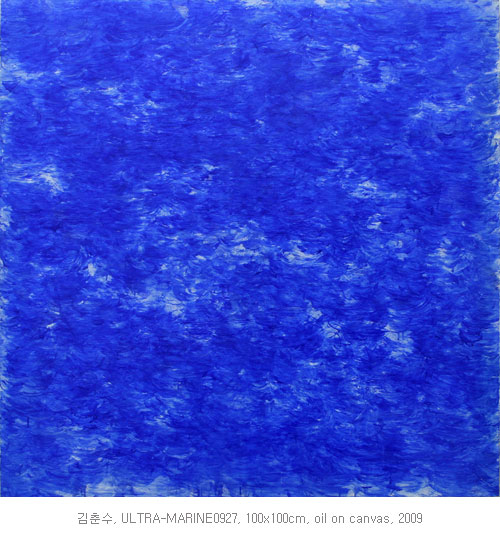
Nevertheless, the qualities of the previous paintings are also maintained in the new works. The elements of direction, which cross the picture-plane diagonally, ease the previous tendencies of steepness, but are still perceivable. The intensity of the hand-work is moving to a more calm state from its previous aggressive tendency, but as mentioned above, it has become much more decisive. Hence, the artist is clearly expressing the path and process of his work. To art historians like myself, such clear signs of development are welcome and thankful. It means that the thoughts and practices of the artist are undergoing logical development, and serves as grounds to say that his work is consistent and progressive. Kim Tschoon-Su's paintings in this exhibition approach the origin of painterly traits, demonstrating the ultimate power of time. They are like a documentation recording the affairs of a journey to escape from the sea of conception.
|
|